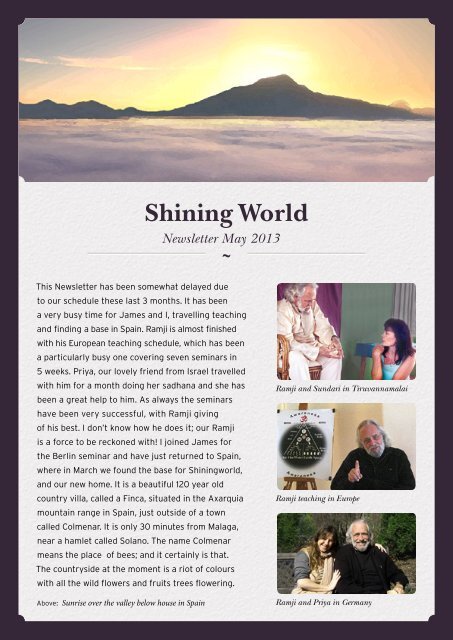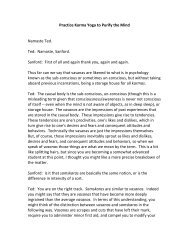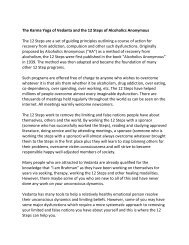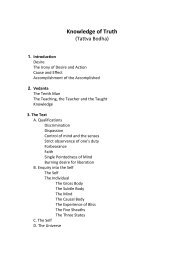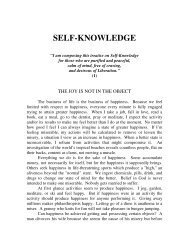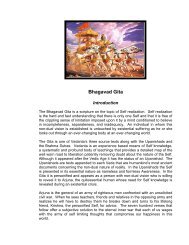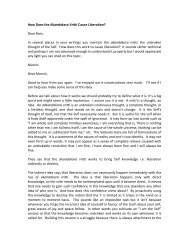May 2013 Newsletter - Shiningworld
May 2013 Newsletter - Shiningworld
May 2013 Newsletter - Shiningworld
- No tags were found...
Create successful ePaper yourself
Turn your PDF publications into a flip-book with our unique Google optimized e-Paper software.
Here is what Ramji had to say to him...“<strong>Shiningworld</strong> is not an organization. It is a group of likeminded friends whose sadhana isserving Vedanta. It confers no status to be part of this group. The rules are established andenforced by Isvara. I encouraged others to write satsangs to refine their understanding andtheir ability to communicate because Isvara has other duties for me. The idea is only torespond to queries from seekers, not to complain about the qualifications of the endorsees.We encourage communication as friends. The dharma of friendship is the dharma of <strong>Shiningworld</strong>as it is the dharma of Vedanta teaching. Krishna and Arjuna were friends. Friends treat eachother as equals. They do not set themselves apart by doubting each other’s authenticity.Friendship is based on the non-dual nature of reality.”This sums it up. <strong>Shiningworld</strong> is a friend to everyone and has no agenda other than to beof assistance to those who are seeking self-knowledge. Those of us who uphold and supportshiningworld do so because of our love for the truth and we make no claim to be perfector beyond reproach as people. We all have our characters and particular style that mayoffend some people. However Vedanta has nothing to do with who we are as people, althoughas qualified teachers we share a common goal and work as a team. We are only doing whatwe do to serve the truth and the people that come to us, to the best of our ability. Ramjihas dedicated his life to the dissemination of Vedanta and has left a trail of happiness in hiswake. He gives tirelessly of himself to anyone who comes to him. What is there for anyoneto complain about? So, please note that in future all complaints will be taken from this position,meaning they will not be taken seriously at all!~Peering in from the sky, Spain7
Teaching Schedule<strong>2013</strong>/2014{USA}Toronto.14th – 16th June <strong>2013</strong>Contact: Paul Newton, Email: panewton@gmail.comText: Self InquiryPrinceton, New Jersey.21st – 23rd June, <strong>2013</strong>Contact: Christine AbrahamsEmail: christineabrahams219@gmail.comText: Self InquiryGolden, Colorado.28th – 30th June <strong>2013</strong>Contact: Christian Leeby,Email: christian@yogaman.comText: Self InquiryBerkeley, California.19th – 23rd JulyContact: Martina Schneider,Email: martinaschneider108@gmail.comText: Bhagavad Gita~ ~Oregon, Trout Lake.1st – 6th August <strong>2013</strong>Contact: SundariEmail: Sundari.shiningworld@gmail.comFor Venue information contact: Kay CoryellEmail: coryell@hevanet.com Text: Bhagavad GitaSalt Spring Island, Vancouver Canada.23rd – 27th August <strong>2013</strong>Contact: Indica Jehman, Email: indica@prakaasha.caText: First section: 23rd – 25th: Self InquirySecond session: 25th – 27th: PanchadasiKripalu, Massachusetts.30th August – 2nd SeptemberVenue: Kripalu CentreContact: http://kripalu.org/program/view/ISI-131/introduction_to_self_inquiryText: Self InquiryTeaching Scheduleso far for 2014{SPAIN}Malaga.3rd – 18th January 2014Contact: SundariEmail: Sundari.shiningworld@gmail.com.Venue: Casa <strong>May</strong>or: for accommodation informationand reservations contact: Deirdra CrowleyEmail: casamayor@yesterdaysbread.co.ukLink for venue: http://www.yesterdaysbread.co.uk/Venue.htmlText: To be announced{GERMANY}Westerwald.9th –14th March 2014Contact: see events on shiningworld websiteVenue: Yoga VidyaText: To be announced{SPAIN}Malaga.5th – 12th April 2014Contact: SundariEmail: Sundari.shiningworld@gmail.comVenue: Casa <strong>May</strong>or; for accommodation informationand reservations, contact: Deirdra CrowleyEmail: casamayor@yesterdaysbread.co.ukLink for venue: http://www.yesterdaysbread.co.uk/Venue.htmlText: To be announced{NORWAY}Norway.28th <strong>May</strong> – 1st June 2014Contact: Bjarke NautsdalEmail: ask@retreat.noVenue: Scandinavian Yoga and Mediation School;Text: To be Announced{SPAIN}Malaga.19th – 26th October <strong>2013</strong>Contact: SundariEmail: Sundari.shiningworld@gmail.comVenue: Casa <strong>May</strong>or: for accommodation informationand reservations, contact: Deirdra Crowley:Email: casamayor@yesterdaysbread.co.ukLink for venue: http://www.yesterdaysbread.co.uk/Venue.html Text: To be announced{GERMANY}Germany, Berlin.5th – 13th June 2014Contact: Matthias RaetzEmail: ramjiseminar@gmail.comVenue: Rosenwaldhof see eventson shiningworld website for more detailsText: To be announced8
~Theme for this <strong>Newsletter</strong>Isvara – Jiva – Jagat& the GunasWe have been focussing on this topic for quite some time now as it is such an important onethat it cannot be over-stated. James and I have been gathering material for a book and thefollowing e-satsangs that I have added to the <strong>Newsletter</strong> form the broad strokes of the book.The first one is one I wrote a while ago and have since re-written and developed. It still has tobe properly fleshed out and the first few paragraphs especially are possibly hard to follow. Thisis because it is difficult to explain such subtle information in such a condensed format. Belowmine I have added two e-satsangs that Ramji wrote on the same theme. These two e-satsangsbeautifully paraphrase Isvara, <strong>May</strong>a, the two creation theories and the topic of evil, as onlyRamji in his inimitably clear, concise and powerfully succinct style can do.~ Isvara Jiva Jagat and the GunasIsvara-Jiva-Jagat Identity (Aikyam): The four ‘Orders of Reality’:Awareness before the projection of <strong>May</strong>a is referred to as ‘pure’ consciousness/awareness orparamatman, amongst many other names, including Isvara. ‘Pure’ serves to define awarenessas having no qualities, but is not actually a good word because it implies that awareness couldbe ‘impure’, which it cannot. However what is important to understand is that it is used todistinguish ‘pure’ awareness from awareness plus <strong>May</strong>a. The word ‘before’ is also not correctbecause there is no before or after in awareness. Ram explains this beautifully in the e-satsangbelow mine where he unfolds two creation theories. Time and space do not apply to awarenessas they are objects known to it. As Edwin our editor beautifully puts it: Definitions are the stuffof duality, but they bring the clarity that helps us transcend it.~ <strong>May</strong>a is a power (shakti) that exists in awareness, or it would not be unlimited. It only ‘covers’a small ‘portion’ of awareness. We have to use the words ‘covers’ and ‘portion’ in order to teach,but they are not strictly speaking correct because they have spatial and temporal implicationswhile awareness is beyond space and time and has no parts. <strong>May</strong>a is the principle that givesrise to duality. It is also called ignorance.~ Isvara Once <strong>May</strong>a is operating awareness ‘assumes’ the role of creator and apparentlyidentifies with <strong>May</strong>a. Awareness in association with <strong>May</strong>a (ignorance) is then referred to asIsvara or ‘God,’ the creator, preserver and destroyer of the objects in the dharmafield. As suchit is also known as the macrosmic mind, the causal body or the deep sleep state. Isvara or<strong>May</strong>a is a ‘limiting adjunct’ for awareness in that it causes awareness to appear as the limitedworld. Again this implies a sequence of ‘events’ which is not correct, because it infers time;we describe it so because we need to understand the distinction between the real and theapparently real, sattya and mithya. (Read James’ e-satsangs below; he explains this beautifully).9
~ Jiva Awareness, under the spell of <strong>May</strong>a, identified with the subtle body, is called jiva. Thesubtle body is an uphadi or limiting adjunct for awareness. The jiva is the microcosmic mindor individual. The subtle body is made up of the mind, intellect and ego. Sometimes the jiva isdefined as awareness plus the five sheaths: the physical sheath (anandamayakosa), the vitalair sheath (pranamayakosa), the emotional sheath (manomayakosa), the intellect sheath(vignamayakosa) and the bliss sheath (anandamayakosa). There is only one jiva because thereis only one awareness appearing as many apparent jivas or individuals.~ Jagat Awareness appears as the creation (jagat) when ignorance (<strong>May</strong>a) is operating. It is aneffect and is called the apparent (mithya) reality. It includes all the gross and subtle objects inexistence, the objective empirical world and the subjective psychological world.~ Gunas The creation comes into existence with the emergence of the 3 gunas: sattva, tamasand rajas. Sattva is intelligence and knowledge; tamas, a heavy dense energy is matter thesubstance of the creation; rajas is the dynamic active energy also known that transforms objects.Psychologically it is known as the mode of action and desire. The gunas make up everything increation, from thoughts to gross objects. In effect, the gunas is another word for Isvara.~ Isvara plus jiva and jagat make up the dharmafield. Their common identity is non-dual reality,awareness, out of which these four ‘orders’ arise. Although they share a common identity asawareness, they are not the same as pure awareness. However all the orders and the objectswithin them depend on awareness, but awareness is always free of them. A good analogy is H2O.Water is pure H2O. So are the ocean (Isvara) and the wave (jiva/jagat). But while the wave and theocean are dependent on the H2O, the H2O is free of both the wave and the ocean. Pure awarenessis free of Isvara, jiva and jagat, but Isvara-jiva-jagat has a dependent existence on awareness.~ Self Knowledge, Self-Realisation, Self-Actualisation and Moksha:Moksha is discriminating awareness from the objects in it. Understanding the Isvara-jiva-jagatidentity (aikyam) is of paramount importance because the Gunas are Isvara, meaning theenvironment, which includes the jiva. It is important not only to discriminate the self from theobjects, but to actualise what it means to be self realised in the apparent reality.This is because self-realisation is not moksha. Hear that again.~ What is Self-realisation? Self-realisation is an experiential term and means that onehas understood that one’s true nature is awareness. However self-realisation is an experience.It is therefore not real in the light of Vedanta’s definition of what constitutes reality as thatwhich is always present and never changes. Meaning you can ‘lose’ your self-realisation, if theknowledge “I am awareness” is not firm.~ What is self-actualisation? To be self actualized means (1) that one has fullydiscriminated the self from the objects appearing in it (the dharmafield, one’s conditioning)and (2) that that knowledge has (a) rendered the vasanas non-binding and (b) destroyed one’ssense of doership. Moksha is discriminating the self from the not-self. Through discrimination,10
the jiva, the individual under the spell of self ignorance, understands that it is actually the self,limitless awareness and not the person it thinks it is. Moksha is for the jiva because the self isalready free. This knowledge allows the jiva to live free in this apparent reality. This means thatthe jiva is not bound by his or her conditioning.~ The Gunas or the RopesThe word guna means rope, aptly named because the 3 gunas are bound to each other and theybind the person to objects. As the components that make up the dharmafield, the gunas governthe creation of everything. This of course, includes the vasanas that motivate the individual and theindividual’s relative nature (svadharma) that gives rise to ‘their’ conditioning. This conditioningis then reinforced by their environment and life experiences, which is also made up of thegunas. So managing the gunas is nothing less than understanding how to relate to the totalityof your environment, your gross and subtle bodies. The gunas are not a problem unless youidentify with them or if you are unaware of them. The gunas are always present and operatingon the jiva and the dharma field because the causal body is there whether the jiva is present ornot, enlightened or not. The gunas condition the jiva or subtle body at all times other than indeep sleep, nirvikalpa samadhi and of course, once the self is actualised as one’s true nature.~ The Three Forces in CreationSattva, rajas and tamas correspond to the three forces in creation: Rajas, vikshepa shakti, whichis the projecting energy; tamas, avarana shakti, the concealing energy and sattva, the revealingenergy. When <strong>May</strong>a operates, sattva (pure knowledge-intelligence) is the first guna to emerge.It is known as pure <strong>May</strong>a and becomes the nature of the mind. Tamas and rajas appear next.Rajas and tamas are the main cause of ignorance; they extrovert the mind, turning it towardsobjects. When a person is sattvic the mind is turned inwards toward awareness, its nature.This happens when rajas and tamas have been largely eliminated. Sattva feels very good. Withkarma yoga and the practice of self knowledge it can become the person’s predominant guna.Purifying the mind is to aim for a sattvic mind.Liberation or self-knowledge means that you have assimilated the knowledge that you arewhole and complete and that the ‘person’ that you used to think you were is no more than anotion in you, awareness. When ignorance (avidya) of yourself as awareness has been removedby self-knowledge, <strong>May</strong>a (macrocosmic ignorance and its effects still obtain and the gunas continueto condition the subtle body (the ‘person’)…but they are rendered non-binding as the doer hasbeen negated by self knowledge. They have nothing to do with you, awareness, because youknow that you are not the Subtle Body, the person/doer. You are trigunatita, beyond the gunas.~ Macrocosmic vasanasThe gunas are called macrocosmic vasanas i.e. they belong to Isvara or the total, the creation,not to the person. As an apparent person or jiva, (the self under the spell of ignorance) theyare in the driver’s seat, so to speak. The person thinks he/she is a doer so they drive him/herrelentlessly until he/she gains the direct knowledge of his/her true nature as awareness.11
There are basically four stages to the guna teaching, which can be applied to peopleat different levels of their spiritual development.~ The Four Stages of the Guna TeachingStage 1. The guna teaching is very effective for doers (karmi’s); these are people in the world,not going for Moksha. As a karmi, one uses the knowledge to accomplish things in the worldand get what one wants. One can gain knowledge of the gunas without realising the self anduse this knowledge very productively to live a better life. It is possible to ‘un-couple’ the gunateaching from Vedanta and apply it “on its own”, so to speak. This would be very useful forpeople in the human resources field, as well as a more enlightened approach to psychologicalcounseling and related therapies.Stage 2. This is for the application of karma yoga. As a karma yogi, how does one reallyunderstand what giving up the results of your actions are, unless you understand what makesup the dharmafield? Also, the karma yogi uses the guna teaching to purify the mind as well asidentify their conditioning. This is the most powerful way to negate the doer.Stage 3. Once the mind is purified, one uses self knowledge to discriminate the self from thenot self. This means that your conditioning does not belong to you. At this stage, unless onereally understands the gunas, many highly qualified inquirers get stuck with the most subtleteaching of all, the relationship between pure awareness and Isvara, jiva and jagat. Remember,it does not work to superimpose satya (pure awareness) on mithya (Isvara, jiva and jagat). Ifsuperimposition happens, even though the self is known, it will remain indirect knowledge i.e.the self will still appear as an object. And one will still think one has to “get” it. Or one will stillwait to have that final experience that will prove he or she is awareness! Direct knowledgeand self actualisation is the difficult part. Therefore, full understanding of the Isvara-jiva-jagatidentity (aikyam) and the guna teaching is of paramount importance.Stage 4. In the fourth and final stage self knowledge has fully removed the ignorance of yourtrue nature and you know without a doubt that you are beyond the gunas. This means thatknowledge and ignorance are both ‘gone’; they are simply objects known to you. Only, you, theself remains. This is moksha.~ Typical Symptoms of Rajas, Tamas and SattvaStart observing them. Each of your thoughts and feelings are guna driven. See which ones aresattvic, which are tamasic and which are rajasic. Understand the implications of identifyingwith each kind of energy and the thoughts they cause. Start observing all objects (the worldaround you or your environment) from this perspective. It will be obvious that no-one is doinganything; it is all a play of the gunas. You will be amazed how clear it all becomes once thegunas are identified: it is like having 20/20 vision.When rajas is operating, the person will be projecting, arrogant, passionate, angry, frantic,over-stimulated/active/driven, extroverted, jittery, can’t sit still, afraid, dissatisfied, insatiable,possessive, jealous, controlling, can’t sleep, bored, wired and tired… (to name a few) Rajas12
triggers fear based thoughts and actions; the person will project their stuff onto ‘others’ orthe ‘world’ and he/she will go “unconscious” (tamas). One tends to speak too quickly, do thingstoo quickly, drop things, bump into things, break them, have accidents and injure oneself. In theextreme he/she will be totally extroverted, driven by passion and desire to gain whatever objecthe/she is fixated on, certain that the joy is in the object. The mind is turned completely outwards.When tamas is operating, the person will be in denial, blaming, holding onto the past or usingit as a reason to justify action or inaction, or as an avoidance strategy to deny his or her fears,making excuses for why he/she can’t be honest or make decisions, rationalising, dithering, livingin potentia, can’t wake up or get out of bed in the morning, exhausted, complaining, dull, lazy,depressed feeling a victim, feeling the wrongs of the world on his shoulders, unloved or that the‘world’ is unloving or a bad place, cruel, uncaring, self absorbed etc. Here the mind is clouded, dull.When sattva is operating, the person is peaceful, calm, clear thinking, balanced, compassionatelyhonest, loving, secure, taking appropriate action, owning all projections, cleaning up his/her karma, dispassionate (especially about his/her own thoughts and feelings), unconcerned,untouched by the opinion of others or the results of his/her actions, enjoying objects for whatthey are i.e. fully aware of all their inherent defects, satisfied, whole and complete... etc.~ How Do the Gunas Function?The gunas are programmed ways of thinking and acting. They are totally predictable. All thegunas build on themselves, so rajas will create more rajas, as will tamas create more tamasand sattva more sattva.The gunas all work together and at any given time, one of them will predominate. Rajasand tamas are inseparable. I call them the ‘terrible twins’. James calls them ‘incestuousbedfellows’. For instance, when rajas is operating, the mind will be projecting outwards andtamas will be right there to deny it. They are just the programmes that run the individual (andeverything else). They are a problem if you do not have the knowledge of how the apparentreality functions, or if you identify with them. For instance, if you find yourself saying “I amrajasic or I am tamasic today”, you are identified with them. The person may be rajasic/tamasic today but you, awareness, are not.Remember, you are the knower of the person; therefore you are the knower of thegunas. Again, whenever you find yourself saying “I” press pause and ask yourself, “who istalking here... which perspective am I identified with, the reflected self (the person) or me,awareness?” If you can consistently do this, it will change your life forever.All three gunas have an upside as well as a downside, as does everything in this apparentreality. Without rajas, you would never get out of bed in the morning or accomplish anything.Rajas is the active, creative ‘force’. It is the mode of passion and desire. Not all desire orpassion is bad however; you need a passion for self inquiry and a strong desire for Moksha. Itis one of the qualifications. Tamas is the very substance of matter, a heavy and steady energy.13
Without it you not be capable of endurance. You would not have the staying power to completeanything and would more or less float off the planet. You would not be ‘earthed’...and youwould never be able to sleep.With too much sattva you can get stuck in a golden cage of experiential bliss, thinking happinessis the Holy Grail and that you are quite special. Sattva is not the be all and end all, even thoughsat, awareness (of which sattva is the most subtle manifestation) is actually the true nature ofthe mind. Sattva however, is a state of mind that is experienced by the doer, the Subtle Body.It is purely experiential and therefore does not last. It certainly will not free the person fromdependence on objects or end the subtle existential suffering that comes with it. It is the lastobject to be released before Moksha. Yet it is a valuable energy for inquiry and should becultivated as it is the guna springboard for self-knowledge. ‘After’ Moksha, sattva or peace ofmind no longer needs to be the goal, although one will still make choices in alignment with it.However once all the objects have been negated along with the doer, it will be there naturallyand if it should not be, that is fine too because you know that as awareness you are beyond sattva.~ Is it Self-Inquiry or a Spiritual Lifestyle?Many spiritual seekers are looking for a way to cope with their unresolved psychologicalissues or as a balm to solve their emotional wounds. Often, they have the vanity to think theyare pure and holy because they have had some kind of transcendental spiritual experiencesor because they have walked away from a samsaric life when their ‘renunciation’ is actuallyescapism. They build a ‘spiritual’ identity that makes them feel less small and afraid. Thisis one of the negative effects of sattva. Being “spiritual” becomes a lifestyle.~ How to Manage the GunasOther than gaining the knowledge of what the gunas areand how they operate, which is half the battle , you can doa great deal to manage them through self knowledge. Thismeans that you know that there are appropriate actions tomaintain peace of mind for the jiva. If you are feeling braindead, depressed or lazy, you can do something physical, liketake a walk or exercise. If you are bouncing off the wallswith extroversion, stress, fear or anxiety, driven by desire oraction….slow down. Skip the coffee, cut down on sugar. Findsome time alone where you can sit quietly and breathe inlight. Once you have calmed down, meditate, sit in silence orlight a candle, do a puja, chant or pray.Our alter in SpainMany enlightened people do not bother managing the gunas and simply accept whatevertranspires in the dharmafield, knowing it has nothing to do with them. This practice is fine ifthe underlying motivation is not a refusal to face binding vasanas; or a way to camouflage thedoer. If the mind is agitated or dull because of your life choices or lifestyle, freedom will not be that14
free unless you acknowledge the cause of the agitation in the light of self-knowledge. This is a commontrap for spiritual seekers and one the ego likes. Often it is not lack of self-knowledge that is the problem.It is just that the ‘self-realised’ person is avoiding doing what it takes to change their behaviour…meaning staring down their vasanas, and getting their actions and lifestyle to conform with dharma.~ Practical Lifestyle ManagementTake a look at your lifestyle and change what you can. Diet is very important for gunamanagement. Learn which foods cause which guna. Examine what you do for a living, howyou recreate, spend money and exercise. Stop hoarding unwanted ‘stuff’ (psychological andotherwise). Examine your relationships with people. Don’t keep company with people who bringyou down. Or, if you can’t avoid them, see how the gunas run them. See where they want thingsto be different and the pain it causes. People can’t help being true to their predominant gunawhen they are unaware that there is choice.The practice of seeing how the gunas operate in yourself and ‘others’, will put you in a wholenew world of perception. Of course there really are no ‘others’ as there is only one self with threegunas - manufactured bodies. By that I mean that they work the same way in everyone. The gunasrun the show for everyone who is identified with the body/mind and the story of personhood.If the predominant guna is tamas, clean out your cupboards; give away everything you don’t reallyneed, stop staying up or getting up late, stop eating tamasic foods, get some exercise. Educateyourself about proper nutrition. Guna management is just common sense. Avoid depressantssuch as alcohol, sleeping pills and drugs. Be constantly on the alert for denial of any kind.If the dominant guna is rajas, be on constant alert for mindless activity, aggression, arrogance,projection, desire and extroversion. Rajas and tamas are the real problem makers. Check yourdiet. Too much sugar, coffee and other stimulants exacerbate rajas and induce it. So do many overthe-counteras well as prescription medications. More than half the planet seems to be on some kindof tranquiliser and it is not hard to see why. James says that rajas is the disease of the 21st century.If you observe too much sattva, stop pretending that you are ‘special’ because you have ‘outof this world’ epiphanies, spiritual knowledge and lots of bliss. Or stop pretending that you arevery holy because you meditate, chant for hours or have an enlightened guru, (or worse, thatyou think you are an enlightened guru). Or you think you have the moral high-ground becauseyou are a vegan/vegetarian and live on sprouts.Get real, keep it humble and keep up the practice of self-knowledge. The point here is that everyonehas a predominant guna which will not only create their most entrenched tendencies, (i.e. vasanas)but it will also be what has conditioned them to have a particular kind of nature. There is no right orwrong here, no better or worse. We do not make ourselves the way we are; Isvara…the gunas…do.The ‘work’ involved in self-inquiry is identifying the gunas through self-knowledge and allowing theknowledge to help ‘you’ manage the gunas by dis-identifying from them and standing as awareness.15
~ You can Choose the GunaOnce you find yourself acting a particular guna out, just observe what is going on. As a personyou have relative free will to choose what action to take to achieve a desired result and thussuccess in the world is possible. One can make ‘the best of one’s life’ as a jiva. However, thosechoices themselves are determined by your conditioning, i.e. Isvara or the gunas. Don’t judge orbeat yourself up, be dispassionate about whatever is going on… it’s a movie after all. Trace backthe train of events, thoughts and feelings to their source and identify what triggered them.The practice of knowledge, the ‘work”, is keeping an eye on the person and his/her likes anddislikes. Make a note of the guna and adjust it in light of the kind of mind you are trying tocreate. Make peace of mind your aim at all costs. Each time you do this, it will get easier tomanage the gunas and it will be easier to recognize them quicker when they appear as yourlikes and dislikes. Consider the likes and dislikes appearing in your mind as red flags, ways toidentify the vasanas that keep a particular program running.It is like playing a computer game: although it appears as if you are making the moves, all themoves that are possible are already programmed into the game. If you keep up the practice ofknowledge, before long, you will have de-activated the like or dislike that keeps the programrunning. It will no longer condition the subtle body, although it may still appear. You will nolonger be a robot acting out unconscious motives by reacting to your environment. If thevasana is still there but you do not have to act on it, it is considered non-binding. As statedabove: understanding the guna teaching means that you understand the nature of yourenvironment, (meaning Isvara) which includes you as a jiva. It is also important to rememberthat it is impossible and unnecessary to de-activate all vasanas. Not all vasanas are bad;you need a vasana for self inquiry and other to motivate yourself. As long as a vasana is notcausing excessive agitation in the mind, it is dharmic. Knowing the nature of the gunas andvasanas renders the doer non-binding.Quote from Edwin on the GunasAs it is with all the teachings of Vedanta, knowledge is power. Sadly, many people try tocontrol the gunas without understanding them. This can lead to a painful exercise in whatis called “will power.” When we do things we recognize as harmful, but don’t understand themechanism at work, we make resolutions, manhandling our psyche, so to speak. Sometimesthese resolutions are kept; often they are broken. And we suffer accordingly.As the gunas are <strong>May</strong>a, they are illusory. They draw us into the world of objects – includingthoughts and feelings – and lead us to identify with these objects. The whole point of identifyingthe gunas, (which are also objects) and managing them is to understand the gunas, not to beafraid of what is bad or become attached to what is good in the gunas.16
~ A Fearless Moral InventoryConduct a fearless inventory of your likes and dislikes and see which guna values they represent.Be totally honest, without shame, blame or fear as you investigate what you are invested in. Bereally alert, like a sharp bird with an acute monocular vision; witness the person you think youare and what goes on in his/her mind and life. Triguna vibhava yoga (managing the gunas) is agreat way to purify your mind and prepare it for enlightenment. All the vasanas and samskaras(a conglomeration of vasanas) are nothing but the results of the gunas and their conditioning.They become binding obstacles (pratibandikas) when they are not understood and controlled.~ Prarabdha Karma, the Effects of Ignorance and Karma YogaIf the effects of ignorance are playing out (prarabdha karma) and you cannot change it, acceptit. Don’t resist. Do what you can to ameliorate them with equanimity and through dharmic lifestylechoices. Know that it is not you and it will pass; this is what Isvara is bringing your way as the jiva andyou must flow with it. Resistance keeps you tied to the person and is a guarantee of more suffering.The gunas are constantly changing and impersonal, like everything else in the apparent reality; whatuse is control? Karma yoga is the only solution as there is no way to fast forward this process.It is common that people who have realised the self, still struggle with stubborn samskaras andwith fears that seem to have no origin. The effects of ignorance take as long as they take tosubside; it is not up to the jiva or to awareness. Fear is an acronym for False Evidence AppearingReal, and is the very nature of rajas. It is part of the fabric of the macrocosmic mind and thejiva being an extension of it has unnamed and gripping fears that emerge from the depths likemonsters from the deep. Rajas and tamas are impersonal and together these two form themain problematic components of ignorance. They are not real. They belong to the causal body,not to you. It only seems like they belong to the jiva because there is always a correspondingstory that comes with them. The gunas belong to Isvara and have nothing to do with awarenessor with the person. The person has a story and has suffered; there is no escape if you are ajiva. As long as one is identified with the person, rajas stalks you every step of the way and thepitfalls of tamas are waiting to engulf you.~ Following DharmaThe knowledge of how the gunas function alleviates existential pain and guilt and gives youX-ray vision into yourself and everyone else. It shows that no-one is doing anything…or ever has.You can stop blaming yourself or anyone else for anything you did or anything that happened‘to you’. Those who think that they are doers have no choice but to follow their natures. Whenyou know you are not the doer, you can choose to drop “your” story’. This is not to say youdo not take appropriate action when required or that you would do harm to any part of thecreation. You would naturally make choices that give peace of mind, (sattva) and causes noinjury, not because you feel guilt or duty bound, but because you are doing what is right.This is what following dharma means.Om and prem, Sundari17
~<strong>May</strong>a or Isvara Which Comes First?It is said in Vedanta that Ishvara wields <strong>May</strong>a.Isn’t it the other way around?James: This is a tricky one because the word Isvara refers to both Pure Awareness without<strong>May</strong>a and Pure Awareness in conjunction with <strong>May</strong>a.Ken: First, there is only pure awareness. Within pure awareness is a potential called ignorance,<strong>May</strong>a. <strong>May</strong>a manifests. Because of <strong>May</strong>a, a small portion of pure awareness projects itself. Thetotality of this projection is called Ishvara. Ishvara is not a ‘person’ but the total aggregate of creationwhich appears as a result of the projection. Ishvara is the structure or system or mechanismor ‘machine’ of the whole of creation with its inherent principles and laws that hold govern andrun creation. It is because of <strong>May</strong>a, ignorance that Ishvara appears. That is, <strong>May</strong>a precedes Ishvara,the creator. The sequence therefore is: awareness -- > <strong>May</strong>a -- > Ishvara. Hence <strong>May</strong>a wields Ishvara.James: In the first place we cannot really speak of a ‘sequence’ because time has not happenedat this level. Time is the interval between events. But the Causal Body (<strong>May</strong>a, Isvara) is the firstevent. We need two more events to come up with time. The third event gives us a way to evaluatethe time/distance between the first two events. In fact creation is simultaneous. It all comes out atonce and there is no time involved. That is why we can negate it. It is not an actual temporal creation.It is a projection. On the Causal ‘level’ there are several things to consider: consciousness, ignorance,the three gunas and the five elements. You can make different arguments for various sequences butthe fact remains that all of these factors are required and they exist in potentia before time.Your definition of Isvara is reasonable. Panchadasi presents both views of the relationshipbetween Isvara and <strong>May</strong>a. Remember it does not have to be one way or the other because Vedantais a means of knowledge and the way it is presented can be tailored to the doubt that is presentedby the student. But your view presents a certain logical problem. Please consider the following:Consciousness…Isvara…is conscious. Therefore it can wield <strong>May</strong>a. Wielding implies a doer,a conscious agent. So in association with <strong>May</strong>a Isvara becomes the Creator (Jagat Karanam)and the dispenser of the results of actions (Karma Phala Datta). But it is not a doer like jiva isa doer. It ‘does’ by its association with <strong>May</strong>a. Its presence causes things to happen. It is like fire.It does not burn in the sense that it does not reach out and grab you and burn you. You getclose to it and you get burned. So you can say it burns…but it doesn’t burn.<strong>May</strong>a is not conscious It is neither consciousness nor not consciousness. It is somethingaltogether different. <strong>May</strong>a is ignorance, the apparent non-apprehension (Avaranna or veiling)of Isvara of itself brought about by Macrocosmic Tamas. Isvara ignorant of its nature is calledJiva. <strong>May</strong>a has another power called projection (Vikeshepa). When it is operating, Isvara saliva18
under the spell of its own Tamas, takes the objects reflected the Subtle Body to be real andbecause it feels incomplete owing to the veiling power of <strong>May</strong>a, it chases objects and suffers. If<strong>May</strong>a is just ignorance and not conscious, how can it ‘wield’ Isvara?The limitation of this model is the fact that <strong>May</strong>a is made of three gunas, not two. So how doyou account for sattva, the revealing aspect of <strong>May</strong>a? It accounts for knowledge, in our case selfknowledge. It appears in <strong>May</strong>a as Vedanta and reveals awareness by removing ignorance about it.Your view is OK. It is: both Isvara and Jiva are projections brought on by <strong>May</strong>a. This is true becauseeverything is awareness and it is unborn i.e. it never did manifest the world. Or to use the popularteaching, ‘nothing ever happened.’ So, in fact there is no Jiva or Isvara. But if thesis true there is no‘sequence’ either.Summary: Vedanta presents creation both as evolution and as superimposition. They are bothuseful to remove ignorance. So you are right and you are not right. :)Love,James~QuestionYou said that awareness shines on the sattva of the causal bodyfirst, then on rajas and tamas. Also, that the problem of evil doesnot belong to awareness but is due to ignorance (rajas and tamas).I’m paraphrasing and maybe I didn’t fully get your drift as this wentby quickly and was not elaborated upon. But isn’t the Causal Bodymade of the three gunas, as it is itself the direct result of ignorance(i.e. <strong>May</strong>a)? So, why would awareness shine on sattva...first?James: It doesn’t really. You have to remember that the purpose of the teachings are to removeignorance of the self, not to give a description of an object, the Causal Body, for example. Yes,the Causal Body is the three gunas but it is more, not that there is anything more than thegunas when you are discriminating awareness from experience.But this teaching is not for discriminating awareness from experience. Although the creationappears all at once because it is just ignorance, for teaching purposes we speak as if there wasa sequence because the inquirer understands things in terms of the apparent reality wheretime is operating so we need to have Isvara appear as pure sattva before rajas and tamasemerge to avoid the problem of blaming Isvara for collective evil. Of course, if any blaming orexplaining is necessary, which it isn’t…‘evil’ is just ignorance of the nature of reality…Isvara asthe three gunas is to blame. But the very idea of creation is ignorance in so far as reality isactually only non-dual pure consciousness.19
The teaching that Isvara is pure sattva is meant to point out that the creation is pure knowledge,uncontaminated with rajas and tamas. Rajas and tamas too are just knowledge in the handsof Isvara, but when they show up in the Subtle Body they apparently delude awareness andit thinks it is a jiva and it subsequently suffers projection and denial. The idea is a set-up toconvince the jiva that it needs to manage rajas and tamas for moksa since sattva, the substanceof the Subtle Body… where ignorance is located jivawise… is required for moksa. It should notblame Isvara and do nothing. You would be surprised how many so called ‘spiritual’ peoplewon’t do sadhana because they believe that the effects of ignorance… their conditioning…whichstands in the way of the assimilation of knowledge cannot be changed. Usually these peoplethink that just knowing the Self changes their conditioning automatically, confers some kind ofspecial ‘state’ that solves all problems.From the relative perspective, jiva and Isvara share more than just their identity as pureawareness, sat. Their upadhis intersect or overlap in such a way that certain jivas, those withalhigh degree of sattva i.e. relatively less rajas and tamas also ‘wield’ rajas and tamas to varyingdegrees with reference to the bit of Isvara i.e. the life stream…read environment…they inhabit.They are ‘little’ Isvara’s (avatars), meaning they have a greater impact on their environmentthan ordinary jivas, who do not have rajas and tamas under their control. Of course they do notmanage macrocosmic ignorance, just their personal ignorance.As well, isn’t so-called evil inherent andtherefore inevitable in <strong>May</strong>a? I mention thisbecause it sort of came off that evil in the worldcould be otherwise. Like, if everyone knew theywere awareness, evil wouldn’t exist. We bothknow that is not going to happen. Could youclarify when you find the time?James: Yes and no. It depends on what you mean by evil. It is ignorance of Isvara, i.e. dharma.If you understand that you are awareness in more than a purely intellectual way, your jiva willappreciate Isvara and align itself with the dharma field (Isvara) in such a way that unnecessaryconflict will disappear. Unnecessary conflict is conflict born out of gratuitous likes and dislikes.It does not serve the evolutionary needs of the total. Of course conflict will not be eliminatedbecause creation does not work without rajas.20
Ram and Sundari at Sans SouciFriends at Sans SouciSunrise over the valley below our house in Spain~21


